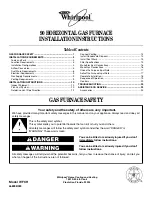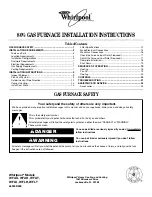
27
shipped set at “B”, and the cooling blower speed is set at “D”.
These blower speeds should be adjusted by the installer to
match the installation requirements so as to provide the cor-
rect heating temperature rise and correct cooling CFM.
Use the dual 7-segment LED display adjacent to the dipswitches
to obtain the approximate airflow quantity. The airflow quantity
is displayed as a number on the display, rounded to the near-
est 100 CFM. The display alternates airflow delivery indication
and the operating mode indication.
Example:
The airflow being delivered is 1225 CFM. The dis-
play indicates 12. If the airflow being delivered is 1275, the
display indicates 13.
1. Determine the tonnage of the cooling system installed
with the furnace. If the cooling capacity is in BTU/hr divide
it by 12,000 to convert capacity to TONs.
Example:
Cooling Capacity of 30,000 BTU/hr.
30,000/12,000 = 2.5 Tons
2. Determine the proper air flow for the cooling system.
Most cooling systems are designed to work with air flows
between 350 and 450 CFM per ton. Most manufacturers
recommend an air flow of about 400 CFM per ton.
Example:
2.5 tons X 400 CFM per ton = 1000 CFM
The cooling system manufacturer’s instructions must be
checked for required air flow. Any electronic air cleaners or
other devices may require specific air flows, consult installa-
tion instructions of those devices for requirements.
3. Knowing the furnace model, locate the high stage cooling
air flow charts in the Specification Sheet applicable to
your model. Look up the cooling air flow determined in
step 2 and find the required cooling speed and adjustment
setting.
Example:
A *MVC80604BX furnace installed with a 2.5
ton air conditioning system. The air flow
needed is 1000 CFM. Looking at the cooling
speed chart for *MVC80604BX, find the air
flow closest to 1000 CFM. A cooling airflow
of 990 CFM can be attained by setting the
cooling speed to “C” and the adjustment to
“-” (minus).
4. Continuous fan speed in legacy mode is 25% of the
furnace’s maximum airflow capability. For continuous
fan speed in communicating mode, see
ComfortNet™
System Overview
on page 29.
Example:
If the furnace’s maximum airflow capability
is 2000 CFM, the continuous fan speed will
be 0.25 x 2000 CFM = 500 CFM.
5. Locate the blower speed selection DIP switches on the
integrated control module. Select the desired “cooling”
speed tap by positioning switches 1 and 2 appropriately.
Select the desired “adjust” tap by positioning switches
3 and 4 appropriately. Refer to the following figure for
switch positions and their corresponding taps. Verify
CFM by noting the number displayed on the dual 7-
segment LED display.
6. The multi-speed circulator blower also offers several
custom ON/OFF ramping profiles. These profiles may
be used to enhance cooling performance and increase
comfort level. The ramping profiles are selected using
DIP switches 5 and 6. Refer to the following figure for
switch positions and their corresponding taps. Refer to
the bullet points below for a description of each ramping
profile. Verify CFM by noting the number displayed on
the dual 7-segment LED display.
5
6
A*
OFF
OFF
B
ON
OFF
C
OFF
ON
D
ON
ON
Switch Bank: S4
DIP Switch No.
(*Indic ates factory setting)
Ramping
Profiles
•
Profile A
provides only an OFF delay of one (1) minute
at 100% of the cooling demand airflow.
OFF
100% CFM
100% CFM
1 min
OFF
•
Profile B
ramps up to full cooling demand airflow by
first stepping up to 50% of the full demand for 30 seconds.
The motor then ramps to 100% of the required airflow. A
one (1) minute OFF delay at 100% of the cooling airflow
is provided.
50% CFM
1/2 min
100% CFM
100% CFM
1 min
OFF
OFF
•
Profile C
ramps up to 85% of the full cooling demand
airflow and operates there for approximately 7 1/2
minutes. The motor then steps up to the full demand
airflow. Profile C also has a one (1) minute 100% OFF
delay.
100% CFM
OFF
OFF
Содержание DVC80603B
Страница 47: ...47 THIS PAGE LEFT INTENTIONALLY BLANK...
















































